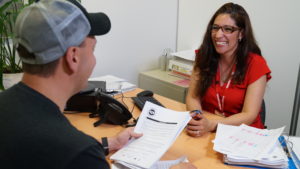Minority groups finding harder to secure jobs – research
 Migrants, refugees, indigenous Australians and the disabled are among minority groups facing extra challenges and barriers when it comes to finding work in Australia, according to a raft of new research.
Migrants, refugees, indigenous Australians and the disabled are among minority groups facing extra challenges and barriers when it comes to finding work in Australia, according to a raft of new research.
Australia’s unemployment rate currently sits at 5.6 per cent, a relatively low figure historically.
But new data from the Australian Bureau of Statistics (ABS) has identified eight minority groups who face disproportionate challenges is securing employment.
Immigrants and refugees, indigenous Australians, the LGBTIQ community, people with disabilities, youth, the elderly, single parents and former prisoners all have higher unemployment rates than the national average.
And researchers say they face significantly higher prejudice and discrimination and thus are more likely to be denied employment opportunities.
Migrants and refugees
According to the 2016 Census, 48 per cent of humanitarian migrants over the age of 15 who received their permanent visa between 2000 and 2016 were in the labour workforce. Of those, 20.3 per cent were unemployed.
Despite many new arrivals being highly skilled and university educated, the struggle to secure new employment is exacerbated by language barriers, transport challenges and workplace prejudices.
The latest ABS data reveals migrants from the Middle East experience more challenges finding jobs than any other immigrants.
The unemployment rate for job seekers from North Africa and Middle East in 2016 was 9.2 per cent, almost four points higher than the national rate of 5.6 per cent,
Indigenous Australians
The 2016 Census also shows the unemployment rate for indigenous Australians was 18.4 per cent, or 2.4 times the non-indigenous rate.
Unemployment is more pronounced in the remote and rural communities where indigenous unemployment rates are more than 28 per cent.
Data collected in the 2014 National Aboriginal and Torres Strait Islander Social Survey (NATSISS), shows labour force participation was lower for women and people living in remote areas.
Recent Australian National University (ANU) identified some of the issues that make it difficult for indigenous people to find and maintain employment.
“On the demand side, the location of jobs, structural changes in the labour market and employer discrimination impact the employment opportunities available to Indigenous people,” the researchers say.
“On the supply side – health, education and training, work experience and caring responsibilities limit the participation of Indigenous people in the workforce,” they said.
The disabled
In 2015, 83 per cent of people without a disability in Australia were in the workforce, compared to only 53 per cent of those who have disabilities.
For people with a severe or profound limitation, workforce participation has dropped from 30 per cent in 2003 to 25 per cent in 2015.
Of the 8,278 inquiries to the Victorian Equal Opportunity and Human Rights Commission in the 2016/17 financial year, almost 1800 were related to disability, making it the most commonly reported form of discrimination.
LGBTIQ people
The unemployment plight of the transgender community is evident in their disproportionately high representation in the country’s homeless shelters.
According to Buzzfeed, one Sydney crisis housing centre estimated that 12 per cent of its clients were transgender women.
The 2014 General Social Survey, carried out by the ABS, found that gay or lesbian people and people with other sexual orientations were more likely to have experienced homelessness than people who identify as heterosexual.
Former prisoners
A study published by the University of Melbourne in 2014 revealed that the majority of ex-prisoners in Australia are unemployed and/or homeless within six months after their release.
And data shows the prisoner population is Australia is growing: in March 2018, the number of imprisoned people in Australia was more than 42,000, a 3.8 per cent increase on the previous year.
Single parents
In 2015, one in three single parents in Australia were unemployed, affecting 302,900 families.
Balancing parenting with workplace responsibilities is a constant struggle for single mums and dads who often face reluctance from employers to provide flexible workplace arrangements.
Youth in the regions
Unemployment among youth (15-24 year old) is currently at 12.2 per cent – more than twice the rate for the general population.
A Brotherhood of St Laurence report in 2018 found Queensland had the highest level of youth unemployment in Australia, with 67.1 per cent of 15 to 24-year-olds without work.
Redundant older workers
Older job seekers are taking longer to find a job – the average length of unemployment for workers aged 55 to 64 is 116 weeks, far exceeding the national average of 46 weeks.
The Australian Human Rights Commission surveyed older jobseekers in 2015 revealing that 27 per cent of people over the age of 50 had experience age discrimination in the workplace.
One third of those who had experienced discrimination gave up looking for work.
This has a significant negative impact not only on individuals, but also the economy and society more broadly, with elderly Australians living longer than ever before and forced to rely on government support in their old age.
Laurie Nowell
AMES Australia Senior Journalist












